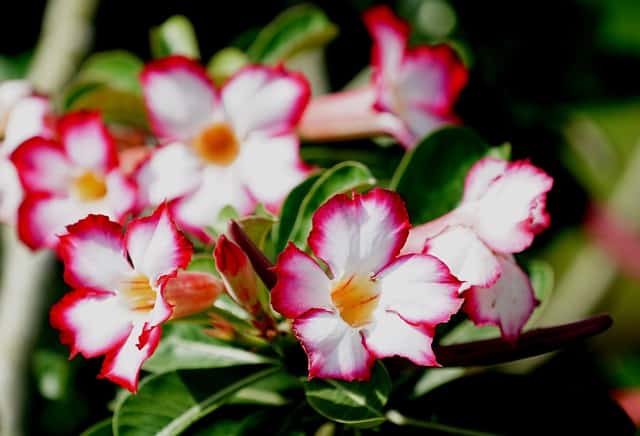Desert Rose is a beautiful succulent plant that is popular for its stunning flowers and unique shape. However, brown spots on the leaves of the desert rose can be a sign of trouble that needs to be addressed. Brown spots on desert rose leaves can be caused by a variety of factors, including overwatering, poor drainage, nutrient deficiencies, and pests.
Identifying the cause of brown spots on desert rose leaves is important for effective treatment and prevention. Environmental factors such as temperature, humidity, and light can also affect the health of desert roses.
Proper care and maintenance, including watering, fertilization, and pruning, can help prevent brown spots and keep desert roses healthy. In this article, we will explore the common causes and treatment options for brown spots on desert rose leaves, as well as provide tips for proper care and maintenance of these beautiful plants.
Key Takeaways
- Brown spots on desert rose leaves can be caused by a variety of factors, including overwatering, nutrient deficiencies, and pests.
- Identifying the cause of brown spots is important for effective treatment and prevention.
- Proper care and maintenance, including watering, fertilization, and pruning, can help prevent brown spots and keep desert roses healthy.
Also don’t miss:
- Cucumber Leaves Turning Yellow with Brown Spots
- Chinese Evergreen Brown Spots on Leaves
- Cannabis Leaves Yellow with Brown Spots
Identifying Brown Spots on Desert Rose Leaves

Desert roses are beautiful succulent plants that are known for their colorful flowers and unique shapes. However, sometimes they may develop brown spots on their leaves, which can be an indication of an underlying problem. Identifying the cause of brown spots on desert rose leaves is important to prevent further damage to the plant.
Causes of Brown Spots
Brown spots on desert rose leaves can be caused by a variety of factors, including:
- Overwatering: Desert roses are drought-tolerant plants and do not require frequent watering. Overwatering can lead to root rot and cause brown spots on the leaves.
- Underwatering: On the other hand, if the plant is not receiving enough water, it may develop brown spots on the leaves.
- Pest infestation: Pests such as spider mites, mealybugs, and scale insects can also cause brown spots on desert rose leaves.
- Fungal or bacterial infection: Fungal or bacterial infections can cause brown spots on the leaves and may also lead to leaf drop.
Identifying Brown Spots
Identifying brown spots on desert rose leaves is relatively easy. The brown spots may appear as small brown dots or large brown patches on the leaves. In some cases, the brown spots may be accompanied by yellowing or wilting of the leaves.
To determine the cause of the brown spots, it is important to examine the plant closely. Check the soil moisture level, inspect the leaves for pests or signs of infection, and look for any other symptoms such as leaf drop or discoloration.
Prevention and Treatment
Preventing brown spots on desert rose leaves involves proper watering and care. Water the plant only when the soil is dry to the touch, and make sure the plant is planted in well-draining soil. Avoid over-fertilizing the plant, as this can also lead to brown spots on the leaves.
If the plant has already developed brown spots, treatment will depend on the cause. If the cause is overwatering, reduce the amount of water the plant receives. If the cause is a pest infestation, treat the plant with an appropriate pesticide. Additionally, removing the affected leaves can help to promote new growth.
Desert Rose Brown Spots Leaves – 3 Common Problems
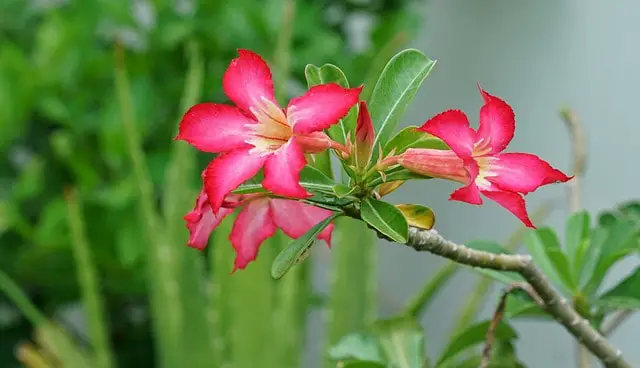
Desert Rose plants are known for their beautiful flowers and unique shape. However, brown spots on the leaves can be a common problem for these plants. There are several reasons why brown spots may appear on Desert Rose leaves. In this section, we will discuss some of the most common causes for brown spots.
1. Overwatering and Underwatering
One of the most common causes of brown spots on Desert Rose leaves is overwatering or underwatering. Overwatering can cause the roots to become waterlogged, which can lead to root rot and other fungal diseases. On the other hand, underwatering can cause the plant to become dehydrated, which can lead to stress and brown spots on the leaves.
To avoid overwatering, make sure that the soil is well-draining and that you allow the soil to dry out partially between waterings. To avoid underwatering, make sure that you water the plant thoroughly when you do water it, and that you do not let the soil dry out completely.
2. Fungal Diseases
Fungal diseases can also cause brown spots on Desert Rose leaves. Leaf spot disease, for example, is a common fungal disease that can cause brown spots on the leaves. This disease is usually caused by too much humidity and poor ventilation.
To prevent fungal diseases, make sure that the plant has good air circulation and that you do not overwater it. If you notice any signs of fungal disease, such as brown spots on the leaves, you should remove the affected leaves and treat the plant with a fungicide.
3. Pests and Insects
Several pests and insects can also cause brown spots on Desert Rose leaves. Spider mites and thrips are two common culprits that feed on the plant’s sap, which can cause brown spots to appear on the leaves. Mealybugs and scale insects can also cause brown spots.
To prevent pests and insects, make sure that you inspect the plant regularly and remove any pests that you find. You can also treat the plant with an insecticidal soap or oil to prevent infestations.
Environmental Factors Affecting Desert Rose
Desert Roses are succulent plants that are native to arid regions of Africa and Arabia. They are prized for their striking appearance and ability to thrive in hot and dry conditions. However, like all plants, they are affected by environmental factors that can impact their growth and health.
In this section, we will discuss the three main environmental factors that can affect Desert Rose: Light Exposure, Temperature Control, and Humidity Levels.
Light Exposure
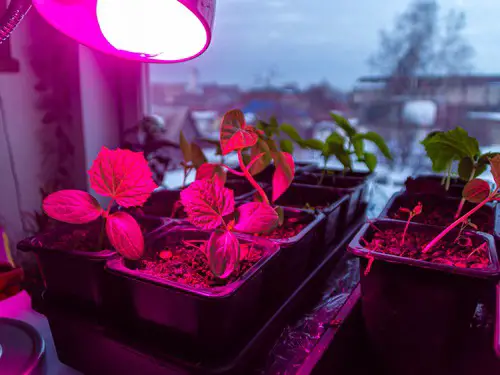
Light is essential for the growth and development of Desert Rose. However, too much or too little light can cause problems for the plant. Insufficient light can cause the leaves to turn brown and fall off, while direct sunlight can cause damage to the leaves and stem. Therefore, it is important to provide the plant with the right amount of light.
If the plant is kept indoors, it should be placed near a window that receives bright, indirect sunlight. If the plant is kept outdoors, it should be placed in a location that receives partial shade during the hottest part of the day. If the plant is not receiving enough light, supplemental lighting can be provided using grow lights.
Temperature Control
Desert Rose is a tropical plant that thrives in warm temperatures. However, it is important to avoid exposing the plant to extreme temperatures, as this can cause damage to the leaves and stem. The ideal temperature range for Desert Rose is between 60°F and 85°F.
If the temperature drops below 60°F, the plant may become dormant and stop growing. If the temperature rises above 85°F, the plant may become stressed and develop brown spots on the leaves. Therefore, it is important to keep the plant in a location where the temperature is consistent and within the ideal range.
Humidity Levels
Desert Rose is a succulent plant that is adapted to dry conditions. Therefore, it does not require high levels of humidity. In fact, high levels of humidity can cause problems for the plant, such as fungal diseases and root rot.
The ideal humidity range for Desert Rose is between 30% and 50%. If the humidity levels are too low, the plant may develop brown spots on the leaves and become stressed. If the humidity levels are too high, the plant may develop fungal diseases and root rot.
Therefore, it is important to keep the plant in a location where the humidity levels are within the ideal range.
Treatment and Prevention of Brown Spots
Desert Rose brown spots on leaves can be treated and prevented by following proper care practices. Here are some sub-sections on how to treat and prevent brown spots:
1. Proper Watering Schedule
One of the most common causes of brown spots on Desert Rose leaves is overwatering or underwatering. To avoid this, it is essential to follow a proper watering schedule. Desert Rose plants require watering when the soil is dry to the touch.
The frequency of watering depends on the temperature, humidity, and sunlight. In general, it is recommended to water the plant once a week in the summer and once every two weeks in the winter.
2. Using Fungicides and Pesticides
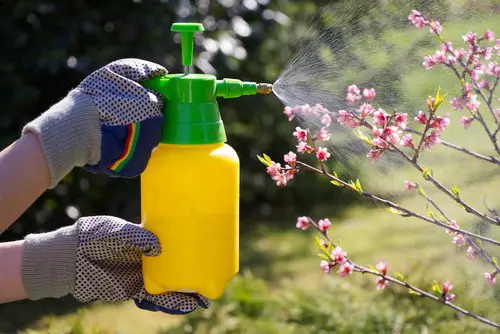
If the cause of brown spots on Desert Rose leaves is a fungal or bacterial infection or a pest infestation, using appropriate fungicides or pesticides can help treat the plant. However, it is essential to identify the specific problem before applying any chemicals.
Some common fungal diseases that affect Desert Rose plants are powdery mildew and black spot. Insect pests that attack Desert Rose plants include spider mites and mealybugs.
3. Proper Pruning Practices
Proper pruning practices can prevent brown spots on Desert Rose leaves. Pruning helps to remove dead and damaged leaves, which can harbor fungal diseases and pests. It also promotes healthy growth and encourages the plant to produce more flowers.
When pruning, it is essential to use clean and sharp pruning shears to avoid damaging the plant. It is recommended to prune Desert Rose plants in the spring before new growth appears.
Nutrient Needs and Fertilization
1. Understanding Essential Nutrients
Desert rose plants require specific essential nutrients to thrive, including nitrogen, phosphorus, and potassium. Nitrogen is essential for leaf growth, while phosphorus is necessary for root development and flower production.
Potassium helps the plant to withstand drought and other stresses. Iron is also an essential nutrient for desert rose plants, as it helps to prevent leaf yellowing and promotes healthy growth.
It is important to understand the nutrient needs of desert rose plants to ensure that they are healthy and vibrant. Lack of proper nutrients can lead to brown spots on the leaves, stunted growth, and poor flowering. Over-fertilization, on the other hand, can cause root damage and leaf burn.
2. Choosing the Right Fertilizer
When it comes to fertilizing desert rose plants, it is important to choose the right fertilizer. A balanced fertilizer with an NPK ratio of 10-10-10 or 20-20-20 is recommended. This ratio provides equal amounts of nitrogen, phosphorus, and potassium, which is ideal for promoting healthy growth and flowering.
It is important to note that desert rose plants do not require frequent fertilization. Over-fertilization can cause root damage and leaf burn. Fertilize the plant once every 2-3 months during the growing season, which is typically from spring to fall.
In addition to a balanced fertilizer, desert rose plants may benefit from a fertilizer that contains iron. Iron is essential for preventing leaf yellowing and promoting healthy growth. A fertilizer with chelated iron is ideal, as it is easily absorbed by the plant.
Proper Care and Maintenance of Desert Rose
1. Soil and Potting Mix
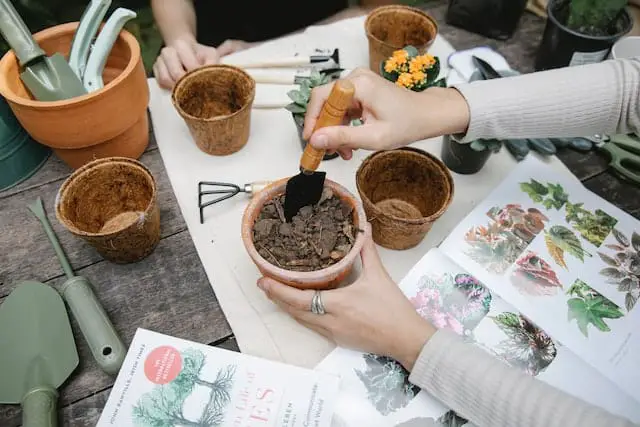
Desert roses require well-draining soil to prevent root rot, which can be fatal to the plant. A mixture of sand, perlite, and peat moss is a good option. Alternatively, a cactus soil mix can also be used. It is important to avoid using heavy, clay-based soil as it retains too much moisture.
When repotting, choose a pot that is only slightly larger than the current one. Desert roses prefer to be slightly root-bound. Repotting should only be done every two to three years.
2. Seasonal Care
In the spring and summer, desert roses require frequent watering. The soil should be allowed to dry out slightly between waterings. Fertilizer can be applied every two weeks with a balanced fertilizer or a fertilizer high in phosphorus.
In the fall and winter, watering should be reduced. Desert roses are susceptible to root rot during the winter months, so it is important to avoid overwatering. The plant should be kept in a warm location with plenty of sunlight.
3. Maintenance
Pruning is an important part of maintaining a healthy desert rose. Dead or yellowing leaves should be removed promptly to prevent the spread of disease. Additionally, pruning can encourage new growth and promote a bushier plant.
Pest infestations should be treated promptly to prevent damage to the plant. Common pests include spider mites, mealybugs, and scale insects. Insecticidal soap or neem oil can be used to treat infestations.
Overwintering can be done indoors in a warm, bright location. The plant should be kept away from drafts and cold temperatures. Watering should be reduced, and fertilizer should not be applied during this time.
Special Considerations for Indoor Desert Roses
When it comes to growing desert roses indoors, there are a few special considerations to keep in mind. These plants are native to arid regions and have adapted to survive in low humidity environments. Therefore, it is important to provide the right conditions to ensure they thrive.
1. Lighting
Desert roses require bright, direct sunlight to thrive. When grown indoors, it is important to place the plant in a south-facing window or under grow lights to ensure it receives enough light. If the plant is not getting enough light, it may become leggy and the leaves may turn yellow.
2. Temperature
Desert roses prefer warm temperatures and should be kept in a room with a temperature between 60 and 80 degrees Fahrenheit. They are sensitive to cold temperatures and should be kept away from drafty windows or doors.
3. Humidity

One of the biggest challenges of growing desert roses indoors is maintaining the right humidity levels. In general, desert roses prefer low humidity environments, so it is important to avoid overwatering and to provide good drainage. However, in dry indoor environments, the air can become too dry, causing the leaves to dry out and turn brown.
To combat this, it is recommended to use a humidifier or to mist the leaves regularly to increase the humidity around the plant. Another option is to place the pot on a pebble tray filled with water to increase the humidity around the plant.
It is important to note that while desert roses can tolerate moderate to high humidity levels, they should not be kept in constantly wet soil.
4. Fertilization
Desert roses should be fertilized regularly during the growing season with a balanced fertilizer. However, it is important not to over-fertilize as this can cause salt buildup in the soil and damage the roots. It is recommended to fertilize once a month during the growing season and to reduce fertilization during the winter months when the plant is dormant.
Frequently Asked Questions
What causes black spots on desert rose leaves?
Black spots on desert rose leaves can be caused by different factors such as fungal infections, pests, and overwatering. Fungal infections like Anthracnose and Cercospora can cause black spots on the leaves.
Pests like spider mites, thrips, and mealybugs can also cause black spots on the leaves. Overwatering can lead to root rot, which can cause the leaves to turn black.
How can I treat fungus on my desert rose?
To treat fungus on your desert rose, you can use a fungicide. There are different types of fungicides available in the market, but it is best to choose a systemic fungicide that can be absorbed by the plant and provide long-lasting protection.
Before applying the fungicide, make sure to remove the infected leaves and dispose of them properly to prevent the spread of the fungus.
What is the best fungicide for desert rose?
The best fungicide for desert rose is a systemic fungicide that can be absorbed by the plant and provide long-lasting protection.
Some of the popular fungicides for desert rose include copper-based fungicides, neem oil, and sulfur-based fungicides. It is important to read the label and follow the instructions carefully when applying fungicides.
Why are my desert rose leaves turning yellow and brown?
Desert rose leaves turning yellow and brown can be caused by different factors such as overwatering, underwatering, nutrient deficiency, pests, and diseases. Overwatering can lead to root rot, which can cause the leaves to turn yellow and brown.
Underwatering can cause the leaves to dry out and turn yellow and brown. Nutrient deficiency can also cause the leaves to turn yellow. Pests and diseases can also cause the leaves to turn yellow and brown.
How do I prevent brown spots on my desert rose leaves?
To prevent brown spots on your desert rose leaves, you can follow these tips:
Water your desert rose plant properly. Desert roses do not require much water, so make sure to water them sparingly.
Avoid over-fertilizing your desert rose plant. Too much fertilizer can cause brown spots on the leaves.
Keep your desert rose plant clean and free from pests and diseases. Regularly inspect the plant and remove any infected leaves.
Provide proper ventilation and sunlight to your desert rose plant.
How can I tell if I overwatered my desert rose?
You can tell if you overwatered your desert rose by checking the soil moisture level. Stick your finger in the soil about an inch deep. If the soil feels wet, then you have overwatered your plant.
Overwatering can also cause the leaves to turn yellow and brown, and the roots to rot. To avoid overwatering, make sure to water your desert rose plant sparingly and only when the soil is dry.

Hey, I’m Lisa and I’ve been an avid gardener for over 30 years. I love writing, talking and living in the garden! Feel free to connect with me on my socials below

